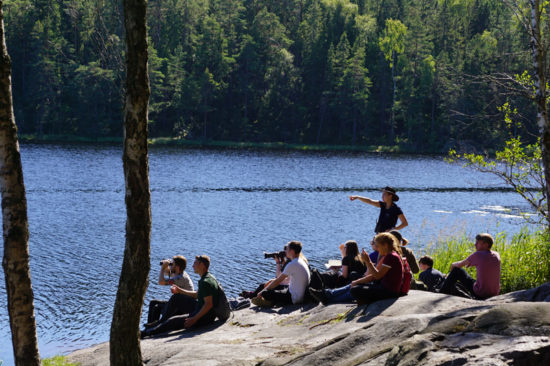I am a zoologist and a science communicator, fluent in English and Polish, interested in behavioural ecology, wildlife conservation, and broader issues, such as women in science or internationalisation of science. Check out my science communication and outreach activities, or my work for the Polish community abroad.
Employment
Current
- Teaching Fellow in Ecology and Zoology at the School of Biological Sciences, University of Reading.
- Communications and Public Engagement Officer at the Department of Paediatrics, University of Oxford.
- Freelance science communicator, collaborating with a number of institutions including the British Council, Centrum Nauki Kopernik, Tygodnik Powszechny or Gazeta Wyborcza.
- Course coordinator for the Oxford Teacher Seminar (Boundaries of Scientific Knowledge), Oxbridge Academic Programs.
Previous
- 2013 – 2014: Lecturer in Wildlife Conservation at the School of Animal, Rural and Environmental Sciences, Nottingham Trent University. Course Leader for the BSc (Hons) in Wildlife Conservation. Modules included biodiversity conservation, ecology, behaviour, science communication, and wildlife genetics and breeding.
- 2013: Senior Scientist at Inscentinel Ltd, a start-up company investigating using honeybees to detect explosives.
- 2009, 2013: Academic teacher, Zoology Department, University of Oxford. Leading laboratory practicals, holding tutorial sessions, and supervising thesis projects (MSc and BSc).
- 2007-2008: Researcher, University of Oxford, Wildlife Conservation Research Unit. Created a report for the Royal Society for the Prevention of Cruelty to Animals, used for promoting collaboration between the fields of animal welfare, biodiversity conservation and international development. An executive summary can be found here: Animals, the Environment and People.
Education
 University of Reading, UK
University of Reading, UK
PGCAP – 2018
University of Oxford, UK
DPhil in Zoology – 2013
MSc in Biology (Integrative Bioscience) – 2007
Jacobs University Bremen, Germany
BSc in Biology – 2006
Rice University, Houston, USA
Semester abroad – 2005
Selected research experience
Biotelemetry and semi-aquatic animals
My doctoral thesis, completed at Oxford University’s Wildlife Conservation Research Unit, focused on investigating the use of miniaturised Time-Depth Recorders (TDRs) for analysing the diving behaviour of semi-aquatic animals. I have used the invasive American mink (Neovison vison) as my model species, and was able to identify dive patterns using TDR depth records, and activity types using TDR temperature records. This work is described in the publications below:
Bagniewska J. M., Harrington, L. A., Hart, T., Harrington A. L., Fasola L. & Macdonald, D. W. (2015) Persistence in diving American mink. Animal Biotelemetry, 3(18), doi: 10.1186/s40317-015-0057-4
Macdonald, D. W., Harrington, L. A., Yamaguchi, N., Thom, M. D. F. & Bagniewska, J. M. (2015) Biology, ecology, and reproduction of American mink Neovison vison on lowland farmland. in Wildlife Conservation on Farmland Volume 2: Conflict in the Countryside, eds. Macdonald, D. W. & Feber, R. E. Oxford University Press, USA.
Bagniewska J. M., Hart, T., Harrington, L. A., & Macdonald, D. W. (2013) Hidden Markov analysis describes dive patterns in semi-aquatic animals. Behavioral Ecology, 24 (3), 659-667.
My doctoral research has been funded by the Crescendum Est-Polonia Foundation, and People’s Trust for Endangered Species.
Scent-station research on South-African canids
 For my MSc project I evaluated the use of scent-stations for monitoring relative densities of populations of African canids (particularly black-backed jackals, bat-eared foxes and cape foxes), at sites in Northern Cape and Free State provinces in South Africa. The research was part of a bigger project on the ecology and interaction of canid species, ran by Dr Jan Kamler. More information on making scent-stations and identifying canid tracks can be found here:
For my MSc project I evaluated the use of scent-stations for monitoring relative densities of populations of African canids (particularly black-backed jackals, bat-eared foxes and cape foxes), at sites in Northern Cape and Free State provinces in South Africa. The research was part of a bigger project on the ecology and interaction of canid species, ran by Dr Jan Kamler. More information on making scent-stations and identifying canid tracks can be found here:
Bagniewska, J. M., & Kamler , J. F. (2007) Scent-station surveys: instruction manual. Wildlife Conservation Research Unit, University of Oxford, United Kingdom.
Bagniewska, J. M., & Kamler, J. F. (2013) Do black-backed jackals suppress numbers of smaller carnivores and prey?. African Journal of Ecology. doi: 10.1111/aje.12125.
My MSc research has been supported by the BBSRC, the John Ray Trust, Zoological Society of London, and St Anne’s College, Oxford.
Some of the methodology has been described in Practical Field Ecology: A Project Guide, by C. Philip Wheater, James R. Bell, Penny A. Cook (2011) Wiley-Blackwell. ISBN: 978-0-470-69429-9
Teaching experience

Loads.
Seriously, loads – anything from early teens to adults, one-on-one tutorials to classes of 300+, lectures, workshops, seminars, field courses, you name it, I’ve done it. Just get in touch if you would like to find out more.